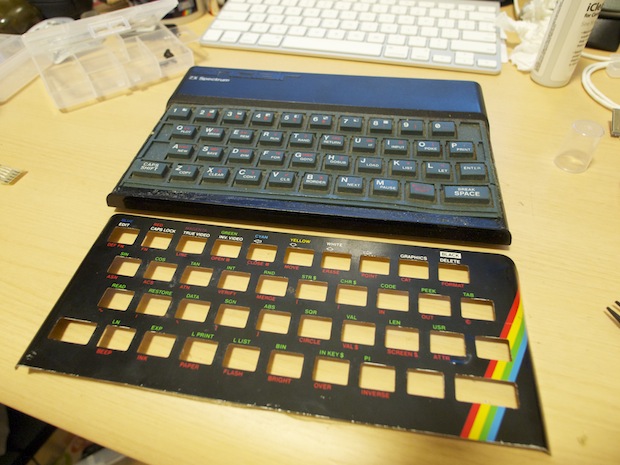One of the 48k's is in great condition, the other, while working fine, was a little shabby, though not too bad. The keyboard sensitivity was not 100%, but OK.
I decided to clean up the shabby one.
It had been repaired, at least twice, with little warranty stickers added. This little speccy was in use until at least 1992.
Keyboard
Removing the keyboard was a pain. The ribbon cables for the keyboard membrane were stuck in the connectors. It was almost as if they had been glued, but is most likely due to the material degrading over time. The cables were very brittle and tore as I was removing them.
Removing the broken cable was also a bit of a pain. I cleaned out the connectors.
This one little screw holds the circuit board onto the bottom of the case.
Quite a few of the RAM chips, including the video DRAM are socketed, and do not match the originals. These must have been replaced.
As the metal faceplate was already loose it easily came off, revealing a keyboard with years of dust, but otherwise OK.
The keyboard popped off easily to reveal the membrane.
I found a retro site selling parts, including brand new faceplates, keyboards and keyboard membranes.
http://www.dataserve-retro.co.uk/
You can even get replacement kits for the little rubber feet of the ZX81, 48k and 48+.
After cleaning up the top of the case, attaching the membrane and keyboard was easy.
Then the faceplate. It's not stuck down in this photo.
The new faceplate isn't quite as nice as the original. The font isn't as bold, and the colours less saturated, with the result that the keywords are less easy to make out. Also, the spectrum logo is a bit off. However, more importantly, the new faceplate is a perfect fit.
Video
Now time for the video modification. Unlike more expensive computers of the era, the speccy 48k did not include output for a monitor - neither RGB nor composite. The only output was a UHF/VHF RF signal for use with a TV. This is a pain, as the frequencies used are now allocated for other channels. So, the speccy cannot be used well as-is with a TV or TV capture card. Fortunately, the composite video signal is fed into the modulator, and a simple modification is all that is required to get a composite signal output. The original TV out socket is a standard RCA socket, so "normal" RCA composite cables can be used without changing the socket.
I followed the instructions here:
http://womblesretrorepairshack.blogspot.com/2008/11/zx-spectrum-composite-video-mod.html
Popping off the top of the modulator box shows a resistor connected to the centre pin of the TV out socket. This carries the RF output signal.
The side view shows the composite video signal being fed into the modulator on the left, and +5v power on the right.
Desoldering these three is not hard, even for me.
Then, all that's required is to connect the composite signal to the centre pin of the TV out socket. The modulator shield is grounded, so no change is needed here.
Not the world's best solder job, but it will do.
I quickly hacked up a composite video cable and... it didn't work. It didn't work because my PSU was set at 6v, not 9v. Doh.
Video quality is not great. There are some more hacks to improve video quality, and even provide S-video output, at this site:
http://user.tninet.se/~vjz762w/rebuild.html
I'll probably get around to doing these one day.
Tapes?
I think the last time I used a cassette was copying a Japanese language test (to MiniDisc!) back in 2001. It's the 21st century and I don't really plan on reliving the "fun" of tapes. So, I bought a DivIDE interface from this guy:
http://www.lotharek.pl/
It works great. The default ROM is FATware which allows loading snapshots (SNA, Z80) and emulating tapes (TAP). It would be even better if it provided the ability to save snapshots. This and more are provided by ResiDOS, but this requires more RAM than the 8k the DivIDE interface provides. DivIDE+, Spectranet and the ZXCF and similar interfaces are all capable of running ResiDOS. As far as I'm aware there is nowhere to buy these pre-assembled. The ZXMatrix looks far, far beyond my abilities to build. The spectranet interface is still under development and looks very promising.
I also bought the Garmin "iMic" USB audio interface, so that I can save to/load from my iMac if necessary.
The finished article. Ready for another 30 years. Maybe.






















